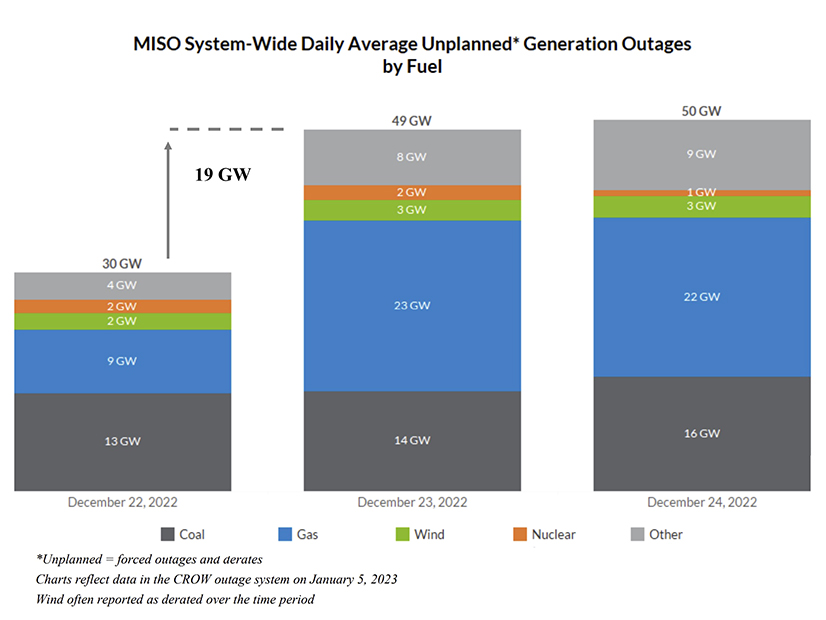MISO told stakeholders Monday that as much as 23 GW of natural gas-fired generation was unavailable during the December winter storm, accounting for almost half of the grid operator’s forced outages.
Staff said during an Entergy Regional State Committee meeting that forced outages reached 50 GW during the last two days of the Dec. 22-24 storm, up from 30 GW during the first day. Natural gas generation outages comprised 23 GW on Dec. 23 and 22 GW on Dec. 24, up from the 9 GW on Dec. 22. Forced coal-resource outages varied between 13 and 16 GW during the storm.
The MISO footprint’s demand hit a likely winter peak of 107 GW on Dec. 23. Demand in MISO South peaked at 32 GW on Dec. 23, nearly matching the South’s record of 32.9 GW set last June.
Staff said gas supply availability issues ultimately tipped the system into emergency procedures on Dec. 23 as they tried to maintain exports to neighboring regions. The maximum-generation emergency lasted for three and a half hours, forcing MISO to call up 1.2 GW of load modifying resources.
MISO’s director of operations risk management, Jason Howard, told the ERSC that pipeline issues and fuel availability, not insufficient weatherization measures, contributed to the unplanned outages. He said staff are working to quantify operations data to better anticipate future winter storms.
In a blog post, Paul Arbaje, an energy analyst with the Union of Concerned Scientists, called the level of outages “troubling” and “equivalent to more than a third of the capacity that should have been available.”
MISO’s operations team drew parallels between this storm and the February 2021 severe-weather event. Howard said although the storm arrived earlier than staff predicted, the severe weather played out as expected. Staff said “abnormally high load forecasting errors” occurred because of a lack of historical data for “similar extreme conditions in December.”
Howard said the storm’s impact over most of the continental U.S. caused MISO and the industry to “really struggle” in gauging demand.
The grid operator’s exports pushed electricity served to 111 GW on Dec. 23. “MISO consistently exported power to southern neighbors with a maximum value of nearly 5 GW,” Howard said. (See MISO Actions During December Storm Spark Debate.)
The RTO said it honored a request to tamp down flows by 1,500 MW across its Midwest-to-South transfer constraint during the Dec. 23 morning peak, which produced emergency conditions in MISO South and a recall of non-firm exports. MISO can normally flow 3,000 MW south and 2,500 MW north across the transmission constraint, part of an agreement with its neighbors.
Scott Wright, executive director of resource adequacy, said because it’s becoming more unpredictable to respond to system operations, MISO has expanded Resource Adequacy Subcommittee meetings into two-day affairs. Staff will use that time to define essential resource attributes, create a new accreditation process for non-thermal generation and design a sloped demand curve for the capacity auction.
“We’re exploring with a conviction that we can do something,” Wright said.



